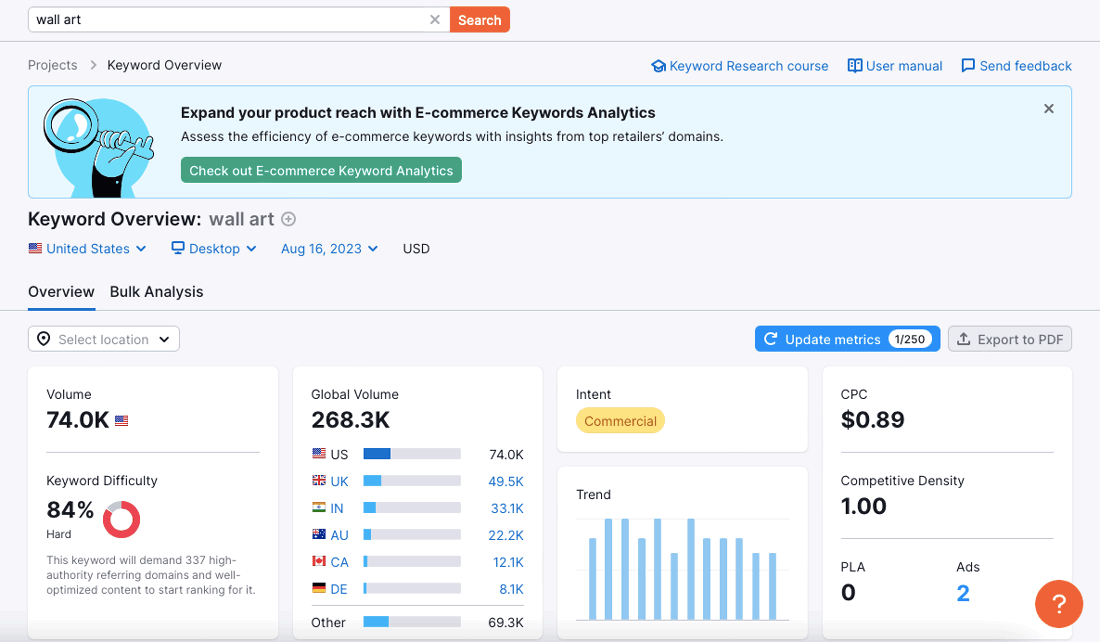Ecommerce SEO: A guide for small businesses

Interested in joining the world's leading print on demand platform?
POV: You’ve just launched the online store you’ve spent weeks building and fine-tuning (and then fine-tuning some more), and now you’re scratching your head, trying to figure out why business is, in fact, not booming.
Firstly, don’t panic. It’s perfectly understandable that you’d want to focus your time and energy on getting your website prepped and ready for customers. The question is eyebrow raise where are they?
Well, the good news is that they’re definitely out there; they just don’t know that you’re out there. It’s nothing a bit of ecommerce SEO can’t fix though.
SEO, which stands for search engine optimisation, refers to the practice of boosting a website's visibility on search engines — aka the virtual highstreet where the majority of your potential customers hang out.
Our guide on SEO for small businesses will teach you some basic ecommerce SEO best practices to help you improve your search engine ranking and drive more traffic to your website. So, let’s get started.
What is SEO?
If you’re interested in reading a more detailed definition of SEO than the one above, then you’ll want to stick around for this section. If not, feel free to keep scrolling.
Using search engines is sort of like asking someone for directions. Take Google, for example. Google has one job: to direct you (the searcher) to where you want to go. Whether you have an exact location (website) or just a general area (websites) in mind, its sole purpose — like any well-meaning direction-giver — is to not only know where you intend on going but also to get you there, or, failing that, to get you as close to your destination as it possibly can.
And in order to do that, search engines rely on something called algorithms — step-by-step instructions or rules that determine the relevance and ranking of websites in response to search queries.
They also employ bots (or “crawlers”) to trawl the internet and analyse all available content. This content is then added to their search index, thus enabling the search engine’s algorithm to assess the suitability of each piece of content in relation to any future search queries. In fact, it’s the algorithm that dictates how well a page will rank for specific search terms.
Case in point: if you type the search query “print on demand tattoos” into Google, you can see that the product page for our custom temporary tattoos is ranked as the number one organic (non-paid) search result for that particular keyword — don’t mind the humblebrag.
Believe it or not, this coveted top spot generates an average click-through rate of 39.8%, with second and third-ranking results receiving 18.7% and 10.2% of traffic share respectively. In other words, your ultimate goal should be for your website to appear within the top three search results.
This is where ecommerce SEO comes in. SEO for small businesses isn’t some unsurmountable peak that only the tech-savvy can conquer — far from it. And to prove our point, here are three basic SEO best practices that’ll help put your ecommerce store on the (Google) map.
1. Perform keyword research
Ah, keywords. The building blocks of SEO, keywords are essentially windows into the minds of your customer base. And with the help of keyword research tools, you can access these keywords and use them to attract customers who want to buy what you’re selling. Ker-ching.
But which keywords should you target? Let’s say you run a print on demand business and sell custom wall art, in which case you might want to target a mixture of short-tail (more generic and typically more competitive) keywords like “wall art” and long-tail (more niche and typically less competitive) keywords like “print on demand wall art”.
While short-tail keywords can help you reach a broader audience, long-tail keywords can capture more specific and intent-driven searches, increasing your chances of ranking higher and attracting customers who are closer to making that all-important purchase. Look out for keywords that are deemed “easy” or “possible” to rank for with decent search volumes to capitalise on. These keywords represent a sweet spot where you can tap into targeted traffic without getting lost in an overly competitive landscape.
Here are some free keyword research tools to help you get started.
2. Optimise your website
On-page SEO involves optimising elements of your webpages to help them rank higher on search engines, including URLs, HTML tags, internal links and all that other good stuff.
In the interest of maintaining chronological order, let’s start with URLs — the webpage address that sits in the browser bar above. According to Google, you want to make sure that the words you use in your URL are relevant to your content. Bonus points if you can squeeze in your primary keyword, too. The more context you can give search engines about your webpages, the better, so be sure to steer clear of complex URLs crammed with unnecessary information and characters.
 Examples of bad (top) and good (bottom) URLs for SEO
Examples of bad (top) and good (bottom) URLs for SEO
Image source
Next up, HTML tags. These little pieces of code control how and where content appears on a webpage. For instance, this blog post features a main heading (or H1 tag) and multiple subheadings (H1 tag, H2 tag, etc.), all of which help structure the content that you’re reading right now, as well as tell search engines which bits are the most important. Similar to URLs, it doesn’t hurt to put your primary keyword in the main heading, either.
And finally, we have internal links. Internal links are the hyperlinks that connect your webpages and help users navigate your site. When using internal links, it’s important to use relevant anchor text — the visible and clickable part of the link — as this helps improve both user experience and search engine understanding.
3. Create quality content
Repeat after us: content is king. You can do all the keyword research and on-page optimisation you like, but if you’re stuffing your content with too many keywords, you run the risk of creating content that’s repetitive and jarring, and ain’t nobody got time for that — least of all Google. Word of warning: if Google does detect unnatural keyword usage, it may decrease a page’s ranking or even remove it from their search results entirely.
Instead, you should focus on creating high-quality content that addresses the needs and interests of your target audience. It also pays to regularly update your website with fresh content, such as blog posts, videos and infographics. Well-written and informative content not only engages your audience but also increases the likelihood of other websites linking to your content, which can enhance your site's authority and, in turn, its search engine ranking.
Want to brush up on your ecommerce SEO copywriting? Ahrefs has some useful tips on how to combine SEO and copywriting techniques to help improve your search engine ranking and boost sales.
To sum up…
Remember, you don’t have to be a tech expert to improve your ecommerce SEO. Anyone can learn basic SEO best practices to help increase their website’s search engine ranking and drive more traffic to their store, including the most novice of online entrepreneurs, so have at 'em.
And if you liked this guide on SEO for small businesses, then you might also like our digital marketing strategy guide. Happy SEOing!
Feeling inspired to launch your own ecommerce store? Create your free Prodigi account, and start designing and selling custom products online today.







